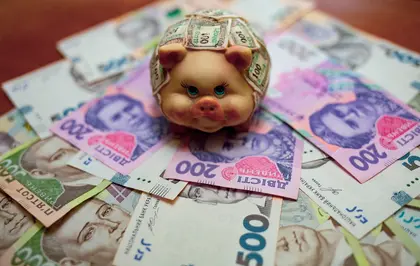On July 21, the NBU abandoned the pre-war official exchange rate of hryvnia vs. US$ and devalued the local currency by 20%. This move is designed to reduce imbalances in the FX market by curbing demand for FX from importers and enhancing supply from exporters.
The central bank will maintain the fixed exchange rate of hryvnia vs US$ as it believes the market still lacks fundamental preconditions for a (managed) floating exchange rate regime. We think a weaker hryvnia will definitely help the NBU preserve part of its reserves, but it is unlikely to reduce external imbalances meaningfully. The NBU also kept its key policy rate unchanged at 25% and projected this rate will not go lower at least until 2Q24.
JOIN US ON TELEGRAM
Follow our coverage of the war on the @Kyivpost_official.
Moreover, upside risks are significant and the NBU will not hesitate to increase the rate further should conditions warrant. The central bank expects that the Ministry of Finance will continue raising yields on government bonds to enhance the transmission effects of the June’s key rate hike and make hryvnia-denominated financial assets more attractive.
– NBU decided to reset the hryvnia exchange rate to UAH36.6/$ as of July 21, down from UAH29.25/$ that had remained unchanged since February 24 when russia began its full-scale invasion of Ukraine. The central bank said this move will help enhance price competitiveness of Ukrainian exporters, reduce demand from importers, and alleviate the multiples exchange rate practice.
– NBU officials commented that the economy and financial sector are not prepared for a (managed) floating exchange rate at this time. A fixed exchange rate is a better option, in particular because it provides a nominal anchor for business and households in times of high volatility of other macroeconomic indicators.
– We believe the NBU’s key goal is to preserve FX reserves, which have started to melt down at an alarming pace. Since mid-May, the NBU has sold on average $900mn per week, and its reserves contracted to $22.8bn at end-June from $29.1bn at end-January (last pre-war month) despite generous inflows of international financial assistance.
– In parallel, the NBU imposed stricter capital controls related to card payments abroad as FX cash withdrawal and payments from hryvnia accounts abroad remain a major channel of FX outflows from the country.
– We believe the one-off hryvnia depreciation will provide some temporary relief to the FX market as imports might weaken and exporters may receive new incentives to sell more FX in the interbank market. However, the new hryvnia exchange rate, which is only 20% weaker vs. US$ and 11% weaker vs. EUR (compared with the pre-war rate), is unlikely to have a decisive effect on the FX market even if coupled with tighter capital controls. The NBU explicitly acknowledges that as it predicts end-2022 reserves will equal $21bn (and will remain largely flat at this level in 2023) despite the expected inflow of about $15bn in international aid by year-end. Thus, an implicit derivation shows that the NBU expects an average net monthly FX sale of about $3bn.
– If the projected significant imbalances are maintained, which we believe is very probable, the NBU may be forced to reset the hryvnia exchange rate to a lower level one more time before end-2022. We give a two-thirds probability to this scenario.
– The NBU said it expected that a weaker hryvnia would have limited impact on inflation. Imported goods make up about one third of the consumer basket and the pass-through of a less expensive hryvnia into prices will be limited and weaker hryvnia will likely eat away at margins of importers. As per the NBU estimates, the recent one-off hryvnia depreciation will have an additional contribution to CPI of 2‒3pp, including a contribution of 0.6‒0.8pp of higher gasoline prices.
– The NBU now sees end-2022 inflation marginally above 30% YoY, which is in line with our projection. Looking forward, the NBU sees CPI decelerating close to 21% by the end of 2023. We see end-2023 CPI higher at above 25%, as we expect the effects of hryvnia depreciation and a gradual adjustment of energy prices to the market level (that we believe is inevitable in 2023) will have a powerful and long-lasting impact on consumer-price dynamics.
– The NBU kept its key policy rate at 25% and indicated it expected the key policy rate would remain at least at this level until 2Q24. Meanwhile, risks are tilted up, and the NBU is ready to increase the rate further if necessitated by unforeseen additional inflationary pressures. The high key policy rate should make hryvnia-denominated financial instruments more attractive to savers and discourage conversion of hryvnia savings into hard currency.
– The central bank welcomed an increase in yields on government bonds last Tuesday to 14%, but made it clear it expected further significant increases in the coming weeks. Higher yields will enhance the transmission of the higher NBU key policy rate into commercial rates, which is critically needed to make hryvnia assets reasonably attractive to investors.
= In our view, this set of bold NBU decisions will somewhat ease pressures on its international reserves and give more breathing space for the next couple of months. However, the fundamental imbalances of Ukraine’s external accounts imply further significant adjustment of the hryvnia exchange rate will be needed in the future. The key game changer for Ukraine’s FX market may be the unblocking of seaports and resumption of unrestricted exports of soft commodities and other products. This scenario is still very unlikely as the green light may only be given by russia to shipments of grains while other commodities will not be covered by concessions.
Research team: Vitaliy Vavryshchuk
Download the full report here.
You can also highlight the text and press Ctrl + Enter



